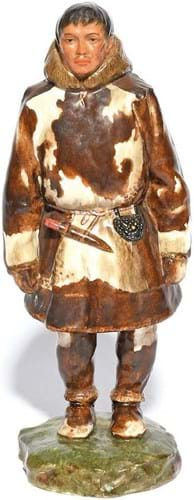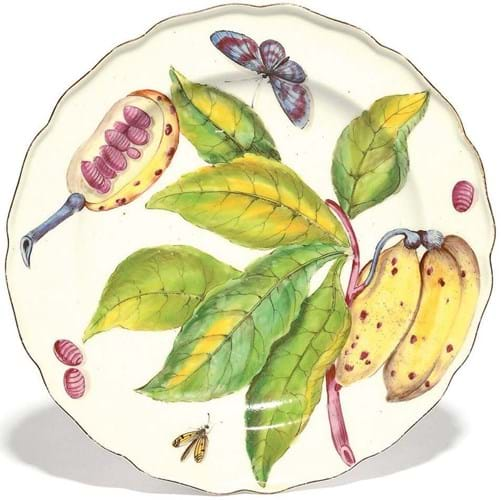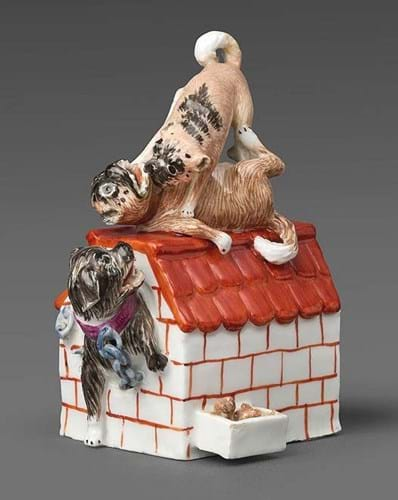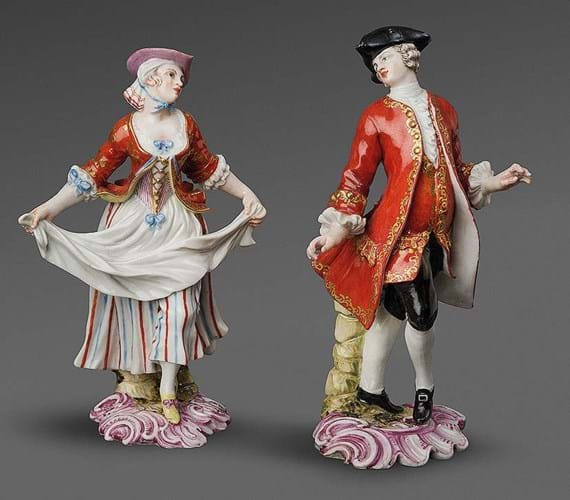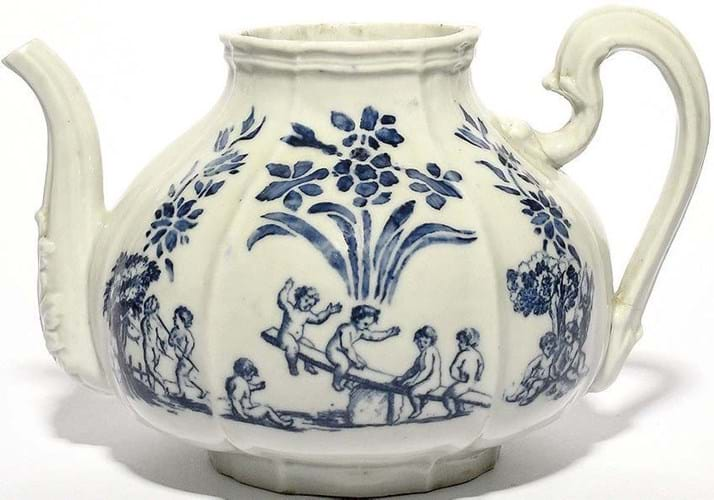
Doccia teapot c.1750-52 with both and stampa transfer printed underglaze blue decoration, £12,000 at Woolley & Wallis.
By 1745, after a decade of experimentation firstly in Florence and then close to his estate in Doccia, the Italian nobleman and entrepreneur Carlo Ginori began selling his porcelain to the public.
His first wares were distinctive for the paste (hard and grey with a tendency to fault in the kiln), the baroque forms (derived from silver pieces in important Florentine collections) and unique form of stencilled underglaze blue decoration.
Considered the earliest attempt at mechanical decoration on European porcelain, the technique known as a stampa or a stampino involved templates based on cut-outs of real flowers.
Renowned sales
The February 21 Fine Pottery and Porcelain sale at Woolley & Wallis (26% buyer’s premium) included several examples. They formed part of the collection of Bernard and Mavis Watney whose vast holdings of 18th century English porcelain were dispersed in a series of sales that are now legend.
It was once thought that a stampa decoration at Doccia gave way to transfer printing. But a teapot in the collection was used by ceramics historian John Mallet to show that the two types of decoration existed side by side (his article Transfer Printing in England and Italy appeared in the Transactions of the English Ceramic Circle in 2011).
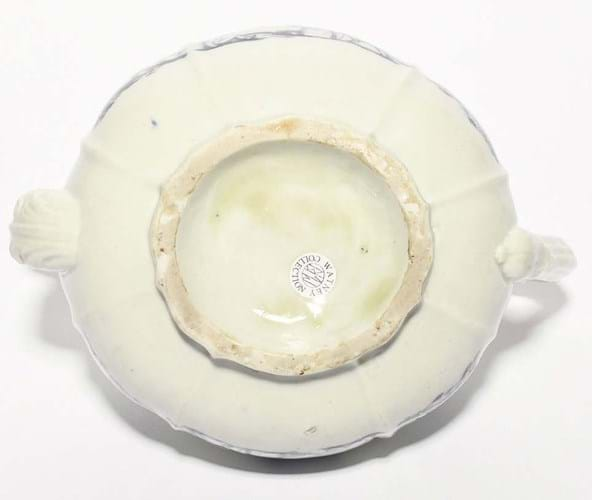
Doccia teapot c.1750-52 with both and stampa transfer printed underglaze blue decoration (detail of the base shown here), £12,000 at Woolley & Wallis.
The fluted baluster form of the teapot combines stencilled flower sprays and leaves with printed decoration of putti at play taken from the Jeux des Enfants series of engravings after Jacques Stella.
It is one of only two recorded, the other in the Victoria and Albert Museum. A classic study piece (the cover is lacking), it improved on its guide of £3000-5000 to sell at £12,000. The other pieces from the collection were more accessibly priced with £400 and £650 bid respectively for an a stampa cup and saucer and a similar fluted dish.
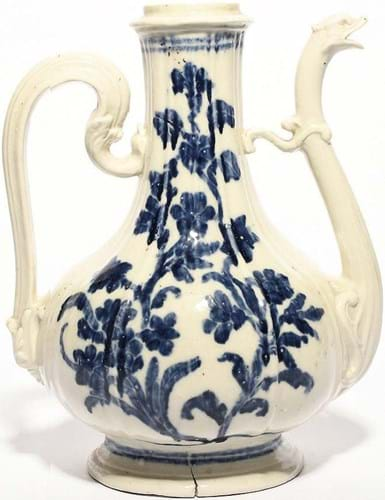
Doccia coffee pot with blue and white a stampa decoration, c.1747-50, the cover lacking, £1600 at Woolley & Wallis.
Imperial portrayals
The other memorable consignment to this Salisbury sale was a group of Imperial Porcelain Factory figures from the Peoples of Russia series. The set (originally supposed to number 400 figures) was commissioned by Tsar Nicholas II to celebrate 300 years of the Romanov rule in Russia and update an earlier 18th century set that was inspired by a book by ethnographer Johann Gottlieb Georghi.
A total of 146 figures representing 73 different ethnicities were sculpted by the artist Pavel Kamensky before the enterprise was cut short by the 1917 Russian Revolution.
“The idea was to celebrate the diverse costumes and cultures that made up the Russian Empire based on the first general census conducted in 1897,” said Woolley & Wallis specialist Clare Durham.
“The figures we sold had been consigned by an English vendor whose ancestor had acquired them in Latvia while working for the British Legation in the 1920s. This was the first time they had been sold in 100 years.”
Given modest guides of between £800 and £2000 each, the seven figures sold for prices of between £9000 for an 8in (20cm) figure of a Malorussian man to £21,000 and £22,000 for a much larger-scale figures of a Chinese man and a Sart women each standing 16in (39cm) high.
“These are near-record prices for figures from this series, which is incredible given the current situation in that part of the world,” Durham added. “It’s impossible to know how much impact world events have on auctions but we erred very heavily on the side of caution.”
The figures were bought by three bidders from the UK and the US.
Plate bears fruit
The sale featured several named private collections in different disciplines. A red anchor Chelsea ‘Hans Sloane’ botanical plate, c.1755- 56, proved the most eagerly contested element of the collection of mainly Chelsea and First Period Worcester formed by former Sotheby’s specialist Clifford Henderson.
Painted with a fruiting branch of Annona (custard apple), a butterfly and another insect, the decoration appears to derive a plate in Christoph Jacob Trew’s Plantae Selectae published in parts in Nuremberg between 1750-73. Purchased from Reeman Dansie in November 2011, here it took £10,000.
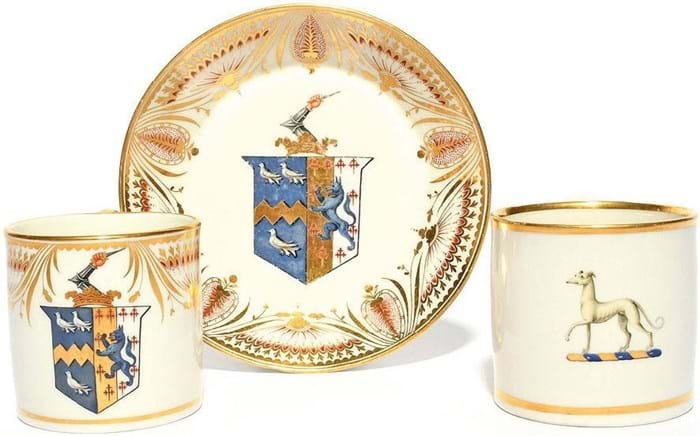
Barr armorial coffee can and saucer and a similar Flight, Barr and Barr coffee can, £1700 at Woolley & Wallis.
A generally affordable offering of Regency porcelain from the Worcester partnerships (the Charles Dawson collection) was topped by three armorial wares.
A Barr armorial coffee can and saucer, c.1800, finely decorated with the arms of Paul Beilby Thompson, later the 1st Baron Wenlock (1784- 1852) of Escrick Park, Yorkshire, was sold together with a Flight, Barr and Barr can painted with a greyhound crest for £1700 (estimate £150-250).
A Meissen figure group modelled as two pugs having a scrap on the roof of the red-tiled kennel is a rarity. Modelled by Kändler this group is described in his ‘taxa’ entry of May 1734 as follows: “On top of this dog kennel are two pugs playing, the old poodle which has crawled out of the doghouse with its tied chain watches with an open mouth, as if he is barking, next to the dog kennel is a small bowl with all sorts of bones.”
Guided at £2500-3500, it took £7000.


